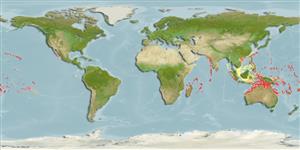>
Perciformes/Serranoidei (Groupers) >
Anthiadidae (Fairy basslets or Streamer basses)
Etymology: Plectranthias: Greek, plektron = anyhting to strike with, spur + Greek, anthias = a fish, Sparus aurata (Ref. 45335); nanus: Named for its small size.
More on author: Randall.
Environment: milieu / climate zone / distribuzione batimetrica / distribution range
Ecologia
marino associati a barriera corallina; distribuzione batimetrica 6 - 65 m (Ref. 90102). Tropical; 28°N - 25°S
Pacific Ocean: widespread, and except for the two Red Sea specimens, this species is not found in the Western Indian Ocean.
Size / Peso / Age
Maturità: Lm ? range ? - ? cm
Max length : 4.0 cm SL maschio/sesso non determinato; (Ref. 8944)
Spine dorsali (totale) : 10; Raggi dorsali molli (totale) : 13 - 15; Spine anali: 3; Raggi anali molli: 6 - 8.
Body shape (shape guide): fusiform / normal; Cross section: compressed.
A secretive species that inhabits coral or rubble habitats of deep channels and exposed reefs (Ref. 1602, 58302). Benthic (Ref. 58302). Solitary in crevices (Ref 90102).
Life cycle and mating behavior
Maturità | Riproduzione | Deposizione | Uova | Fecundity | Larve
Paxton, J.R., D.F. Hoese, G.R. Allen and J.E. Hanley, 1989. Pisces. Petromyzontidae to Carangidae. Zoological Catalogue of Australia, Vol. 7. Australian Government Publishing Service, Canberra, 665 p. (Ref. 7300)
IUCN Red List Status (Ref. 130435: Version 2025-1)
Threat to humans
Harmless
Human uses
Pesca: di potenziale interesse
Strumenti
Special reports
Download XML
Fonti Internet
Estimates based on models
Preferred temperature (Fonte Biblio.
123201): 24.9 - 28.8, mean 27.4 °C (based on 254 cells).
Phylogenetic diversity index (Fonte Biblio.
82804): PD
50 = 0.5000 [Uniqueness, from 0.5 = low to 2.0 = high].
Bayesian length-weight: a=0.01349 (0.00618 - 0.02945), b=3.00 (2.81 - 3.19), in cm total length, based on LWR estimates for this (Sub)family-body shape (Ref.
93245).
Trophic level (Fonte Biblio.
69278): 3.4 ±0.5 se; based on size and trophs of closest relatives
Resilienza (Fonte Biblio.
120179): Alto, tempo minimo di raddoppiamento della popolazione meno di 15 mesi (Preliminary K or Fecundity.).
Fishing Vulnerability (Ref.
59153): Low vulnerability (10 of 100).
🛈
Nutrients (Ref.
124155): Calcium = 229 [99, 559] mg/100g; Iron = 1.23 [0.56, 2.45] mg/100g; Protein = 18.2 [16.2, 20.1] %; Omega3 = 0.222 [0.106, 0.471] g/100g; Selenium = 31.8 [12.5, 73.4] μg/100g; VitaminA = 164 [40, 625] μg/100g; Zinc = 2.58 [1.50, 4.14] mg/100g (wet weight);
